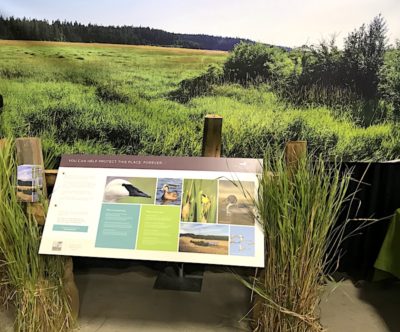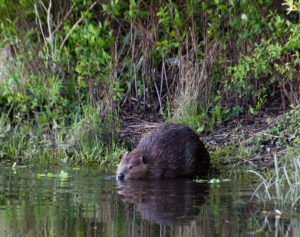
Campaign launch at county fair
“Beaverton” is the name of a scenic valley, a busy road, and the largest freshwater marsh in San Juan County—all located just outside Friday Harbor. Early descriptions of San Juan Island do not record how and when the name originated. It’s clear, though, that beavers populated the area long before non-Native settlers began clearing and draining the wetland for agriculture in the 1860s. The industrious rodents had previously built at least one dam in the lower part of the valley, flooding a boggy forest to create an expansive marsh and giving the area its name. By the 1870s, however, trappers had taken the last beaver out of Beaverton.*
Now, 150 years later, the San Juan Preservation Trust and the San Juan County Land Bank have teamed up to permanently protect the heart of the dam-builders’ marshland legacy. Earlier this year, the Land Bank and a private benefactor purchased a 325-acre parcel that lies between, and now connects, two existing preserves at opposite ends of the marsh, creating a newly consolidated 500-acre publicly owned nature preserve.
To help the Land Bank finance the $2.6 million purchase, the Preservation Trust launched a $1.2 million Campaign for Beaverton Valley Preserve. We kicked off the campaign’s public phase at the San Juan County Fair in August. Gifts of all sizes are being matched by a half-million-dollar challenge grant. Already, thanks to an outpouring of support from a handful of leadership donors and more than 120 additional community members, we are close to reaching our goal.
Even when we do, we’ll welcome more gifts, because contributions above and beyond the $1.2 million goal will help build a dedicated stewardship fund. These funds will assist in restoring wildlife habitat and in developing trails and other amenities that support public enjoyment of the preserve.

Beaver in Seattle-area park | Erin Kohlenberg (CC BY 2.0)
“Something we are very short on in Friday Harbor is walkable nature destinations,” says Lincoln Bormann, Director of the Land Bank. “Beaverton MarshPreserve opens a new universe of possibilities, connecting through conserved agricultural lands to the north, overlooks on the south, and potentially a boardwalk connecting Linde Park to trails on the preserve.”
The newly acquired property ensures permanent protection of the rural character and striking vistas, often shrouded in morning mist, at the edge of the county’s most heavily populated area. The marsh also acts as a giant filter and sponge, serving the vital functions of freshwater purification, storage, and aquifer recharge. Another benefit of wetlands is that they take carbon dioxide out of the air and store it in plant tissue and soil.
Maybe, if enough native habitat can be reclaimed from the invasive reed canary grass that now dominates the wetland, a few of the Castor canadensis that occasionally pass through San Juan Island will decide to stay, once again working as eager ecological engineers and putting the beaver back in Beaverton.
* Source: “Beaverton Valley Marsh: Cultural History Study for the San Juan Preservation Trust,” by Boyd Pratt (July 2019). You can read it here.
